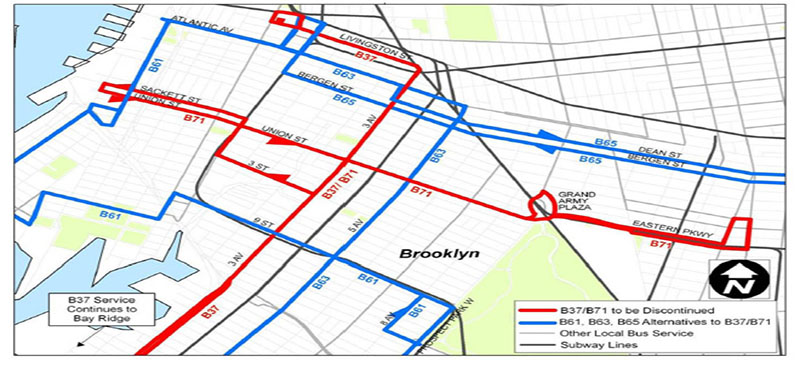NYC Transit 2010 Service Reduction for the B71. Photo Courtesy of the Metropolitan Transit Authority
Hitting six out of six lottery numbers means jackpot. So when all six tables at a Carroll Gardens civic brainstorming session pick the same top priority, that means something too. In this case, the priority was to restore bus route B71.
In November, 23 business owners and 22 residents participated in an advisory committee survey created by the Carroll Gardens Association to plan a commercial corridor for Columbia Waterfront District. The idea was to gather suggestions and wish lists from the community.
The advisory committee was sectioned into six groups, and each marked restoring B71 transportation service as their top priority. No other project was unanimously selected.
“If it came up six times, every table felt it was a priority for the corridor,” said Lindsay Donnellon, Community Program Coordinator for The Carroll Gardens Association.
But it won’t be easy.
In June 2010, the Metropolitan Transit Authority clumped B71 into a group of seven bus lines to be discontinued. It cited an $800 million deficit for the stop.
Three years later, the cut is still fresh. “People liked the B71 because it was a straight route down Union Street to Park Slope and back. Now you have to take the B61 and change to the B65, which goes up 5th Avenue,” said George Fiala, a Brooklyn resident who writes for the Red Hook Star Revue.
Diana Dambale and Beverly DiCovello, residents in Carroll Gardens, say that seniors find it difficult to access senior centers without the route — a thought shared by New York State Assemblywoman Joan L. Millman’s office.
The MTA “cut buses, and they leave seniors and the disabled without a way to get around,” said Josh Levin, Millman’s Community Affairs Director.
The alternative for bus transportation is the subway. But, says Levin, it’s not an alternative for some people.
“The MTA will say subway service an avenue block, two avenue blocks away, can replace the lost bus service, but that doesn’t work for people — seniors, the disabled — because there are no handicap, ADA accessible stations,” Levin said.
After a three-year standoff, community members are ready to press the gas. “You have to lobby the MTA at their board meetings to restore routes,” Fiala said.
And lobbying is well underway.
Millman’s office is in talks with the Transport Workers Union Local 100 to join forces and approach the MTA with a comprehensive plan. It’s based on the model that helped restore the B37 service, a bus line cut alongside the B71, according to Cheska Tolentino, Community Affairs Organizer for the TWU Local 100.
“It’s a social justice issue,” Levin said.
He adds that the coalition isolated groups by socio-economic factors, like race and age, as well as public housing and public assistance, to determine how the loss of the bus was affecting these populations. The coalition plans to do the same thing with the B71 by highlighting the senior population’s reliance on the route.
But recent talks among residents, community members, non-profit organizations, and cultural institutions might be that. Just talk. “There are no plans to bring back the B71,” said Kevin Ortiz, Media Relations Representative for MTA and NYC Transit. “At the time it was discontinued, it ranked eighth from the bottom citywide in terms of total ridership.”
That is: Eighth lowest out of 224 routes.
However, Millman’s office says such rankings don’t tell the whole story. “There are affected populations that are more than just a sample,” Levin said. “They do have a story and do have a reason for why they can’t get to certain places and have had to change their travel plans.”
TWU Local 100 joins in that argument. “The line’s shutdown impedes communities from accessing public institutions such as the Brooklyn Public Library, Brooklyn Museum, Brooklyn Botanic Gardens, schools, cultural institutions, medical centers, and senior care facilities,” Tolentino said.
Levin added, “There is no shortage of complaints about the MTA in our office.”
The effort to restore the B71 could come down to money. The B37 was restored due to a $40 million surplus in MTA’s budget, according to Millman’s office.
“There’s probably other bus lines that they would have rather restored because they had higher ridership numbers,” Levin said. “But there was such a huge push by the community that was very organized.”
He added that Millman’s office and the TWU Local 100 still need to sit down and form a definitive plan to implement the model used to reinstate the B37. Anne Strahle, Millman’s Chief of Staff, said that will happen in January.


Leave a Reply